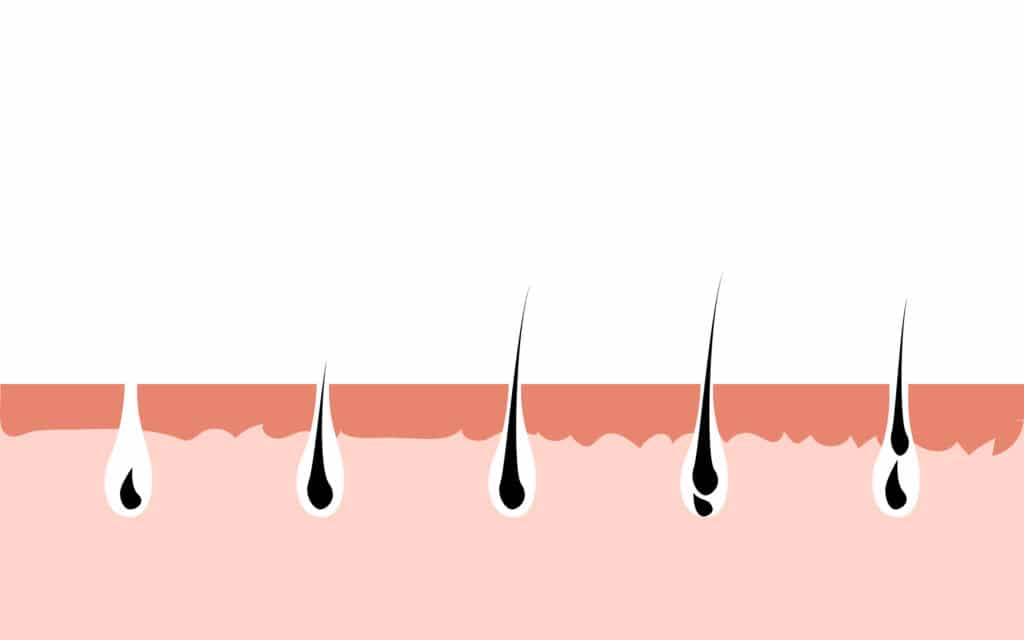Hair loss is a tragedy that many men and women encounter at some point in their lives. Excuse my exaggeration, but the world seems to fall apart when you experience hair loss. It is a disorder that interrupts the hair production cycle in the body. While the hair loss, also called alopecia, can occur on different parts of the body, it mostly targets the scalp. In this article I am going to touch on the different types of hair loss and their causes. Depending on the person, hair thinning and baldness can occur for many different reasons.
Table of Contents
The Hair Growth Cycle

Did you know a protein called Keratin forms our hair? It is present in hair follicles in the outer skin layer. As hair follicles produce new cells, they push the old cells out of the scalp at a rate of six inches per year. The hair you see on the head is a string of dead keratin cells.
While you cannot count the hair on your head, on an average, the scalp has over 100,000 hair strands that pass through the growth cycle. Most people tend to lose 50 to 100 hair strands every day as a part of the natural cycle of growth. Each hair follicle has a unique life cycle; however, various factors, such as, age or diseases, can impact the growth at different stages. Hair goes through the following stages listed below.
- Anagen – It is the phase of active hair growth that usually lasts anywhere between two and eight years.
- Catagen – This is the transitional stage, where the hair stops growing and gets separated from the follicles. It lasts for two to three weeks.
- Telogen – The final stage where the hair follicles rest for two to three months and then fall out.
A disruption in the hair natural cycle or damage to the hair follicle causes the hair to fall out at a faster rate than it is generated. In both cases, you may experience symptoms of hair fall, such as hair shedding in patches, receding hairline, or hair thinning. As you can imagine, individuals suffering from hair loss have hair follicles that remain in the telogen phase for longer periods of time.
Types of Hair Loss
Hair loss is a universal problem that affects millions of people across the globe. However, not all people suffer from the same type of hair loss. Rather, alopecia or hair loss has many types and causes.
Androgenic Alopecia

Androgenic alopecia is the most common type of hair loss. In the US alone, 30 million women and 50 million men suffer from this genetic condition. In case you don’t know, androgenic alopecia or pattern baldness is hereditary, but you can manage it with medication, surgery, or low level light therapy.
- Male Pattern Baldness
Men can begin to suffer from hair loss at any time after puberty; some may even experience hair loss in their teens or early 20s. Male pattern baldness appears as a receding hairline. Eventually, it will cause the hair to disappear from the crown and scalp from the front.
- Female Pattern Baldness
Women may experience the symptoms of pattern baldness as a part of the aging process. Most women don’t see any noticeable hair thinning until they reach 40. However, female pattern baldness can also begin any time after puberty.
In women, hair starts thinning all over the scalp, with the most noticeable effect at the crown. Unlike men, the hairline of women does not recede due to androgenic alopecia.
Alopecia Areata

This is an autoimmune condition that occurs suddenly, causing patchy hair loss in youngsters and children. When the healthy tissues in the body come under the attack of the immune system, they affect the hair follicles. As a result, the hair begins to fall out in small patches and hair loss can begin without any warning signs.
Autoimmune disease does not only affect hair on the head, but also causes eyebrows and eyelashes to fall out. In rare cases, alopecia areata may lead to alopecia totalis, i.e., complete baldness. However, the hair loss reverses in 90% of the people within a few years.
Telogen Effluvium

Telogen effluvium is a type of hair loss that occurs when the hair follicles on the scalp enter the final stage of the hair growth cycle but don’t proceed to the next growth phase. As a result, old hairs begin to fall out all over the scalp, and the growth of new hair completely stops.
People with telogen effluvium may lose 300 to 500 hair strands per day. In addition, they may experience hair thinning at the crown and temples. However, the condition does not lead to complete baldness. The main causes that trigger telogen effluvium include thyroid imbalance, iron deficiency, surgery, fever, or childbirth.
Women are more likely to experience telogen effluvium due to certain factors. For instance, the use of certain medications or blood thinners can trigger hair loss in women. In addition, starting or stopping birth control pills (oral contraceptives) also cause telogen effluvium.
Anagen Effluvium

This type of hair loss occurs as a result of certain medical treatments such as chemotherapy. Radiation and potent medication used to kill cancer cells also affect the production of hair in the scalp and other body parts, such as eyebrows and eyelashes.
However, anagen effluvium is a temporary hair loss, and the hairs grow back after chemotherapy ends. People with anagen effluvium can consult a dermatologist for medicines to help hair growth a faster rate. In addition, healthy diet, and use of vitamins or supplements can also help to regrow hair.
Scarring Alopecia

Scarring alopecia or cicatricial alopecia is a rare type of hair loss. It occurs due to inflammatory skin conditions and disorders that destroy hair follicles. In addition, scarring alopecia causes scar tissues in place of hair follicles. The formation of scar tissues results in permanent hair loss as the hair growth stops completely. Skin conditions that may cause scarring alopecia include acne, cellulitis, and folliculitis.
In most cases, the process begins so gradually that people fail to notice any clear signs or symptoms. However, sometimes the hair may begin to fall suddenly. Some of the symptoms associated with scarring alopecia include swelling, itching, and white or red lesions on the scalp.
Both men and women suffer from this type of hair loss. Tight braiding, use of rollers or hot curlers, and hot combing are a few factors that may lead to scarring alopecia. Severe damage to the scalp can cause permanent bald patches.
Conclusion
Whether you suffer from pattern baldness or telogen effluvium, it is important to know that growing your hair back is possible. A balanced diet, use of vitamins, and certain medications can revoke hair loss. In addition, you can use laser hair growth caps for regrowing your hair follicles on the scalp. This involves no medications, chemicals, or invasive surgeries.
What type of hair loss do you suffer from? What have you found that has helped you restore your hair loss?
Hair Loss Causes FAQs
What is hair loss called?
Hair loss can also be referred to as male and female pattern baldness.
What causes your hair to fall out?
Hair loss can occur due to many different reasons. Some causes are illness, nutrient deficiency, genetics, and medications.
What foods cause hair loss?
Two of the top foods that cause hair loss are processed foods and items that contain artificial sweeteners and sugars such as diet soda.
How long can alopecia last?
This will vary depending on the person. Alopecia could last several months or could remain for the rest of your life.









